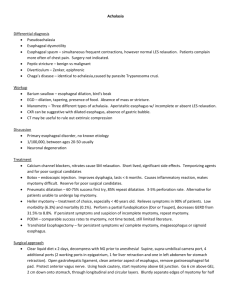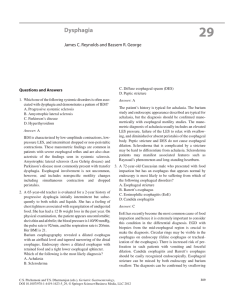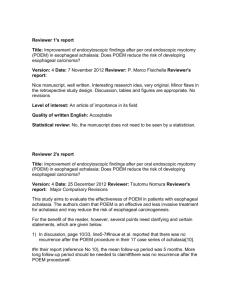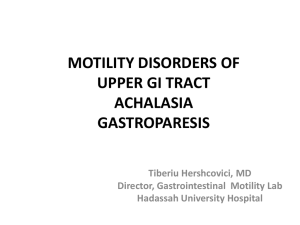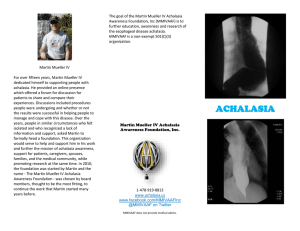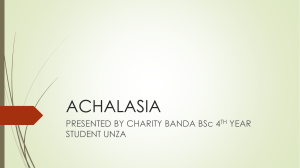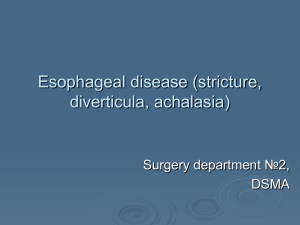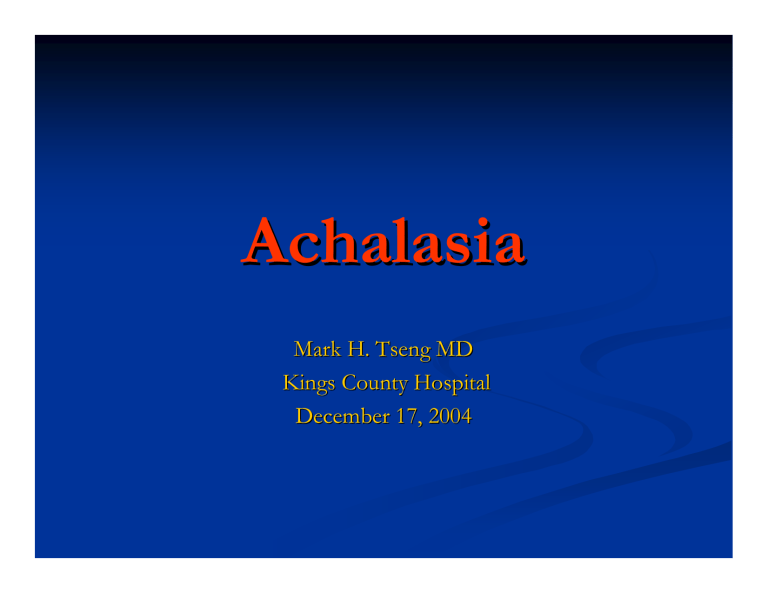
Achalasia Mark H. Tseng MD Kings County Hospital December 17, 2004 Achalasia: overview and mangagement Mark H. Tseng MD Kings County Hospital December 17, 2004 Achalasia I. Anatomy II. Historical Background III. Achalasia IV. Clinical presentation V. Evaluation VI. Treatment Anatomy- esophagus - Muscular tube - Conduit from the pharynx to the stomach - Length is defined anatomically, from cricoid cartilage to the gastric orifice - Distance from the incisor 40-45 cm (actual length: M 22-28cm F 2cm shorter) - Passes behind aortic arch and left main bronchus. - Enters abdomen through esophageal hiatus → 2-4 cm below the diaphragm Anatomy- esophagus Course of the esophagus: - Neck and upper esophagus: left of midline - Mid-esophagus: right of midline - Lower esophagus: left of midline Three area of normal constrictions: - Cricopharangeal - Behind the aortic arch - LES (thickening of the circular muscles ~ 4cm) Anatomy- esophagus - Fixed in position at two places: . Upper: firmly attached to the cricoid cartilage . Lower: Phreno-esophageal ligament to the esophagus which provides an air- tight seal between the thoracic and abdominal cavity. (lack of fixation throughout its length allows both transverse and longitudinal mobility) Vascular supply ARTERIAL SUPPLY Upper → superior and inferior thyroid artery Middle → Bronchial arteries and esophageal branches directly from aorta Lower → L inferior phrenic and gastric VENOUS SUPPLY Upper → esophageal venous plexus to azygos vein Lower → esophageal branches of the coronary vein, a tributary of the portal vein Structure - Consists of 3 layers: muscularis externa, submucosa, mucosa Achalasia-historical note First described more than 300yrs ago Referred to as cardiospasm Thomas Willis (1621-1675) Described a pt starving and unable to swallow Conclusion was due to lower esophageal narrowing Constructed the first dilator-made of whale bone and sponge First successful treatment of achalasia Achalasia-historical note 1914: Ernst Heller (1877-1964) -- First successful cardiomyotomy Anterior and posterior myotomies Extending 8cm or more into esophagus and stomach Achalasia-historical note 1918: De Brune Groenveldt and Zaaijer – performed modified Heller myotomy anterior only Original technique was to excessive Achalasia - Uncommon (0.5-1 in 100,000) No sex predilection M=F Majority between ages 20-50s Ineffective relaxation of the LES combined with loss of esophageal peristalsis → impaired esophageal emptying and gradual dilatation - Decrease or loss of myenteric ganglion cells - Slight increase risk of esophageal carcinoma (approx. 10yrs earlier than the general population) Achalasia - Presentation - Dysphagia - delayed and progressive presentation (mean 2 years) - Exacerabated by emotional stress or cold fluid - 60-90% report spontaneous or forced regurgitation of undigested food - 10% will have pulmonary complication - Chest pain (≠ heartburn) - 30-50% resolves with Myotomy Achalasia - Diagnosis - CXR: air fluid levels - Barium swallow: dilated esophagus with Bird's beak deformity. (pseudoachalasia from extrinsic mass may mimic the classic achalasia appearance) - Manometry: gold standard . Elevated LES pressure (greater than 35mmHg) . Incomplete sphincter relaxation . Complete absence of peristalsis - Endoscopy: dilated esophagus with tightly closed LES → gentle pressure will admit the scope with a "pop“. Achalasia Achalasia Achalasia - Treatment Palliation of dysphagia is the key → relieve functional obstruction of distal esophagus - pharmacotherapy botulinum toxin esophageal dilation operative myotomy Achalasia- algorithm Ferguson MK Ann Thorac Surg 52:336 1991 Achalasia - Treatment - Pharmacotherapy: (poorly absorbed and short lived, best reserved as adjunct to other therapies) - Nitrates Ca++ channel blockers Anticholinergics Opiods Botulinum Toxin Therapy Achalasia - Treatment Botox injection: - Bind to cholinergic nerves and irreversibly inhibit Acetyl Choline release - 60-85% of patient get relief but 50% get recurrent symptoms within 6 months. - Endoscopically injected - For pt who are not candidates for other therapies Achalasia - Treatment Botox injection cont. - Advantages: safety, ease of administration, minimal side effects - Disadvantages: expensive, need for multiple injections, and efficacy decreased with repeated injection - Cause obliteration of the dissection planes between submucosa and muscular layer which will make subsequent surgery more difficult and increase risk of perforation. Eaker, Gordon, Vogel. Untowards effects of esophageal botulinum toxin injection Dig Dis Sci 1997 Pneumatic Dilator Achalasia - Treatment Esophageal dilation (under fluroscopy) -Standard nonoperative therapy -Break the muscle fibers -For pts with limited life expectancy -Can have repeated dilatation -60-80% success rate, 5yr recurrence rate 50% -Efficacy is decreased after second dilatation -Perforation rate ~ 2% -PPI reduces the need for repeat dilatation Csendes A: Late results of a prospective randomisied study comparing forceful dilation Gut 30:299, 1989 Esophageal myotomy Achalasia – Surgical treatment - Excellent results in 90-95% Gold standard 1914 - Ernest Heller- double myotomy Modified by Zaaijer- single myotomy World’s largest experience -Brazil, Chagas’ disease-endemic -1 in 8 inhabitants, in which 5% develops achalasia - Traditionally trans-thoracic or trans-abdominal - Now minimally invasive Laparoscopic / Thoracoscopic - Robotic Heller myotomy Pinotti HW: Surgical complications of Chagas’s disease World J surg 1991 Achalasia – Surgical treatment Indications: Younger than 40yrs old (group which PD is <50%effective) High risk of perforation Esophageal diverticula Previous surgery of GE junction Tortuous or dilated distal esophagus Recurrent symptoms despite Botox or PD therapy Personal choice of therapy Lower risk of perforation Better long term outcome Decrease chance of re-intervention Achalasia – Surgical treatment Expose mucosal surface Length of myotomy Check for perforation Robotic heller myotomy Cephalad: 1-2 cm beyond the dilated esophagus Caudal: 1-2 cm into the gastric musculature or when transverse veins are encountered Meythlene blue Air Complications Intra-op Mucosa perforation Post-op: Dysphagia- adhesion, inadequate myotomy GERD- long myotomy, nerve damage Delay perforation- inadequate myotomy Achalasia – Surgical treatment Which esophageal technique should be used? Any role for anti-reflux procedure? Trans-thoracic Excellent result Less GERD* compare to trans-abdominal * Phreno-esophageal ligament is not disrupted and shorter myotomy No fundoplication is necessary Farshad Abir: surgical treatments of achalasia: current status and controversies. Digestive surgery 2004 Trans-abdominal Excellent result – comparable to trans-thoracic More GERD*, less dysphagia *Longer myotomy onto stomach (3cm) Farshad Abir: surgical treatments of achalasia: current status and controversies. Digestive surgery 2004 Laparoscopic Excellent result *Decrease hospital stay (average 42-48hrs post-op) Improve GERD by antireflux procedure Farshad Abir: surgical treatments of achalasia: current status and controversies. Digestive surgery 2004 Achalasia – Surgical treatment Currently, no prospective randomized trials comparing the various approaches to myotomy Excellent results Technique used should depend on individual surgeon’s comfort and experience Anti-reflux should be performed with abdominal approach
